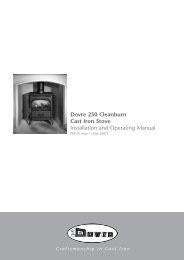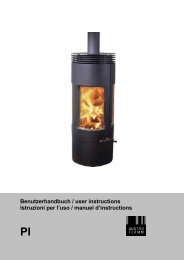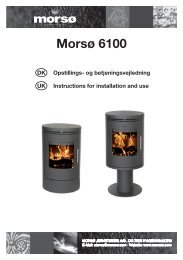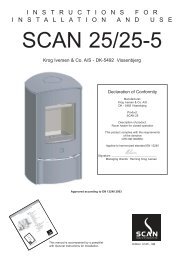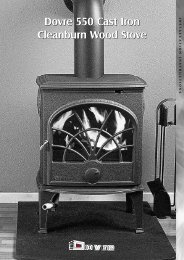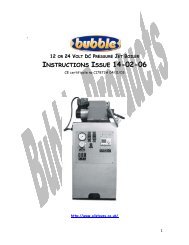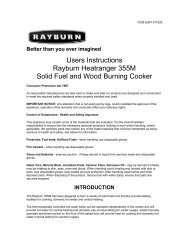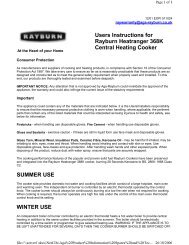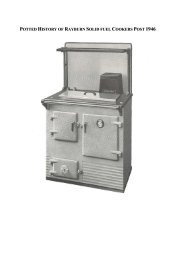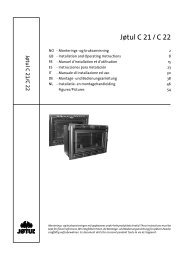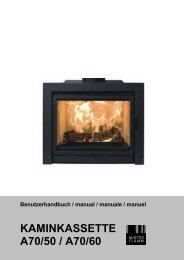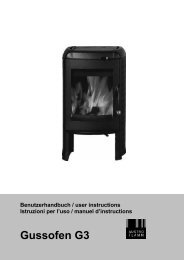Encore®
Encore®
Encore®
Create successful ePaper yourself
Turn your PDF publications into a flip-book with our unique Google optimized e-Paper software.
A stove is part of a system, which includes the chimney,the operator, the fuel, and the home. The other parts ofthe system will affect how well the stove works. Whenthere is a good match between all the parts, the systemworks well.Wood stove or insert operation depends on natural(unforced) draft. Natural draft occurs when the smokeis hotter (and therefore lighter) than the outdoor air atthe top of the chimney. The bigger the temperaturedifference, the stronger the draft. As the smoke risesfrom the chimney it provides suction or ‘draw’ that pullsair into the stove for combustion. A slow, lazy fire withthe stove’s air inlets fully open indicates a weak draft.A brisk fire, supported only by air entering the stovethrough the normal inlets, indicates a good draft. Thestove’s air inlets are passive; they regulate how muchair can enter the stove, but they don’t move air into it.Depending on the features of your installation - steel ormasonry chimney, inside or outside the house, matchedto the stove’s outlet or oversized - your system maywarm up quickly, or it may take a while to warm up andoperate well. With an ‘airtight’ stove or insert, one whichrestricts the amount of air getting into the firebox, thechimney must keep the smoke warm all the way to theoutdoors. Some chimneys do this better than others.Here’s a list of features and their effects.Masonry ChimneyMasonry is a traditional material for chimneys, but itcan perform poorly when it serves an ‘airtight’ stove.Masonry is a very effective ‘heat sink’ - it absorbs a lotof heat. It can cool the smoke enough to diminish draft.The bigger the chimney, the longer it takes to warm up.It’s often very difficult to warm up an outdoor masonrychimney, especially an oversized one, and keep it warmenough to maintain an adequate draft.Steel ChimneyMost factory-made steel chimneys have a layer ofinsulation around the inner flue. This insulation keepsthe smoke warm. The insulation is less dense than masonry,so a steel chimney warms up more quickly thana masonry chimney. Steel doesn’t have the good looksof masonry, but it performs much better.Indoor / Outdoor locationBecause the chimney must keep the smoke warm, it’sbest to locate it inside the house. This uses the houseas insulation for the flue and allows some heat releaseinto the home. An indoor chimney won’t lose its heatto the outdoors, so it takes less heat from the stove toheat it up and keep it warm.Draft ManagementEncore ® Multi-Fuel HeaterFlue SizingThe inside size of a chimney for an ‘airtight’ stoveshould match the size of the stove’s flue outlet. Whena chimney serves an airtight, more is not better; in fact,it can be a disadvantage. Hot gases lose heat throughexpansion; if we vent a stove with a 152 mm 96”) fluecollar {181 sq cm (28 sq. in.) area} into a 254 x 254 mm(10” x 10”) flue, the gases expand to over three timestheir original size. This cools the gases, which weakensdraft strength. If an oversized flue is also outsidethe house, the heat it absorbs gets transferred to theoutdoor air and the flue usually stays cool.It’s common for a masonry flue, especially one servinga fireplace, to be oversized for the stove. It can takequite a while to warm up such a flue, and the resultscan be disappointing. The best solution to an oversizedflue is an insulated steel chimney liner, the same diameteras the stove or insert’s flue outlet; the liner keepsthe smoke warm, and the result is a stronger draft. Anuninsulated liner is a second choice - the liner keepsthe smoke restricted to its original size, but the smokestill must warm up the air around the liner. This makesthe warm-up process take longer.Pipe & Chimney LayoutEvery turn the smoke must take as it travels to thechimney top will slow it down. The ideal pipe and chimneylayout is straight up from the stove, to a completelystraight chimney. If you’re starting from scratch, use thislayout if possible. If the stovepipe must elbow to enter achimney, locate the thimble about midway between thestove top and the ceiling. This achieves several goals:it lets the smoke speed up before it must turn, it leavessome pipe in the room for heat transfer, and it gives youlong-term flexibility for installing a different stove withoutrelocating the thimble.There should be no more than 2.4 m (8’) of single-wallstove pipe between the stove and a chimney; longerruns can cool the smoke enough to cause draft andcreosote problems. Use double-wall stove pipe for longruns.Single ventingEach ‘airtight’ stove requires its own flue. If an airtightstove is vented to a flue that also serves an open fireplace,or a leakier stove, it’s easier for the chimney draftto pull air in through those channels than it is to pull airthrough the airtight, and performance suffers. Imaginea vacuum cleaner with a hole in the hose to see the effecthere. In some cases the other appliance can evencause a negative draft through the airtight, and result ina dangerous draft reversal.200097117



